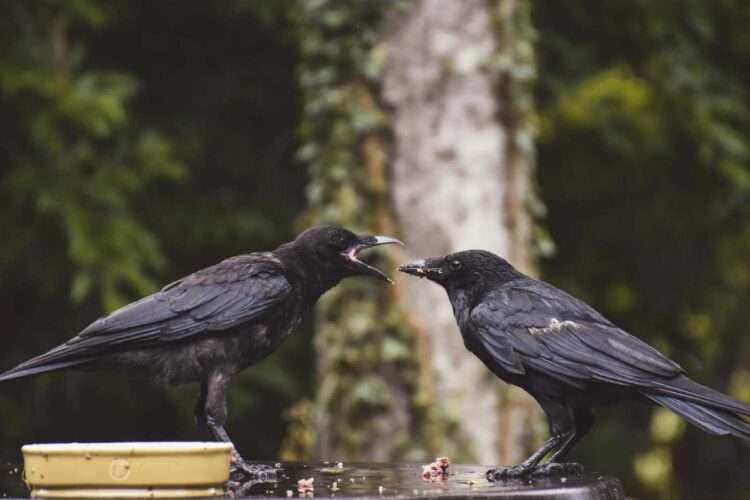Crows are fascinating creatures known for their intelligence, but have you ever wondered what they eat? Let’s explore the diverse diet of crows and discover how these adaptable birds find food in various environments.
Crows are more than just the black birds you see perched on telephone wires; they’re intelligent creatures with a surprisingly varied diet. Understanding what crows eat can give us insight into their adaptability and role in the ecosystem.
A Feast Fit for a Crow: The Omnivorous Diet
Crows are omnivores, which means they eat both plants and animals. Their diet is incredibly diverse, allowing them to thrive in different habitats, from forests to urban cities.
Insects and Small Animals
One of the primary food sources for crows is insects. They eat beetles, grasshoppers, spiders, and even caterpillars. According to the Cornell Lab of Ornithology, crows also hunt small animals like mice, frogs, and lizards. Their keen eyesight and intelligence make them effective hunters.
Fruits and Seeds
Crows enjoy a variety of fruits and seeds. They feed on berries, nuts, and grains, especially during seasons when insects are scarce. This plant-based part of their diet helps them survive in different environments and seasons.
Carrion and Waste
Crows are scavengers, meaning they eat dead animals, known as carrion. This not only provides them with food but also helps clean up the environment. In urban areas, crows often feed on human waste and garbage. National Geographic notes that crows have been seen rummaging through trash bins and picking up leftover food.
Human Food and Adaptability
In cities, crows have adapted to eat almost anything they can find. From leftover pizza slices to french fries dropped on the sidewalk, they are not picky eaters. This adaptability has allowed crows to live comfortably alongside humans.
How Do Crows Find Their Food?
Crows are highly intelligent and have excellent problem-solving skills. They use these abilities to locate and obtain food in clever ways.
Tool Use
Some crow species, like the New Caledonian crow, are known to use tools to get food. They might use sticks to dig insects out of tree bark or bend wires to reach food in tight spaces. Smithsonian Magazine reports that this tool use is a sign of advanced cognitive abilities.
Cooperative Hunting
Crows sometimes work together to hunt or scavenge for food. They communicate with each other using a complex system of calls. This teamwork increases their chances of finding food and keeping each other safe.
Memory and Learning
Crows have remarkable memories. They can remember food locations and even recall which areas have more abundant resources. According to a study by the University of Washington, crows can remember human faces and associate them with positive or negative experiences, which can help them find food or avoid danger.
Seasonal Changes in Diet
The diet of crows can change with the seasons. Let’s see how their food choices adapt throughout the year.
Spring and Summer
During warmer months, insects and small animals are plentiful. Crows take advantage of this abundance by feeding on caterpillars, worms, and other insects that are easy to find.
Fall
In the fall, crows shift to eating more fruits, nuts, and grains. They might visit farms and fields to eat leftover crops like corn and wheat. This is also the time when they store food for the winter.
Winter
Winter can be challenging, but crows are resourceful. They rely on stored food, scavenging, and human waste. Their ability to eat a wide range of foods helps them survive even in harsh conditions.
Crows and the Ecosystem
Crows play an essential role in the environment. By eating insects and small rodents, they help control pest populations. As scavengers, they assist in decomposing dead animals, which recycles nutrients back into the soil.
Seed Dispersal
When crows eat fruits and berries, they often carry seeds away from the parent plant. When these seeds are dropped elsewhere, they can grow into new plants, helping with forest regeneration.
Interactions with Humans
Crows’ eating habits sometimes bring them into conflict with people.
Crop Damage
Farmers may view crows as pests because they can damage crops by eating seeds and grains. However, their consumption of insects can also benefit agriculture by reducing pests.
Urban Challenges
In cities, crows might scatter garbage or make noise while searching for food. Understanding their behavior can help us find ways to coexist peacefully.
Feeding Crows: Dos and Don’ts
Some people enjoy feeding crows and observing their behavior. If you choose to feed crows, it’s essential to do it responsibly.
What to Feed
- Healthy Options: Offer unsalted peanuts, fruits, and grains.
- Limit Junk Food: Avoid giving them processed or sugary foods.
What to Avoid
- No Harmful Foods: Do not feed crows foods that are toxic to birds, like chocolate or avocado.
- Avoid Dependency: Don’t feed them so much that they become dependent on humans for food.
Legal Considerations
Always check local regulations, as feeding wildlife is restricted in some areas.
Fun Facts About Crows’ Eating Habits
- Tool Makers: New Caledonian crows are known to make hooks from twigs to extract insects.
- Nut Crackers: Some crows drop nuts onto roads for cars to crack them open.
- Meat Eaters: They can occasionally hunt other birds or raid nests for eggs.
Conclusion
Crows are intelligent and adaptable birds with a diverse diet that includes insects, fruits, small animals, and even human leftovers. Their eating habits showcase their problem-solving skills and ability to thrive in various environments. By understanding what crows eat, we can appreciate these remarkable birds and their role in our world.
References




